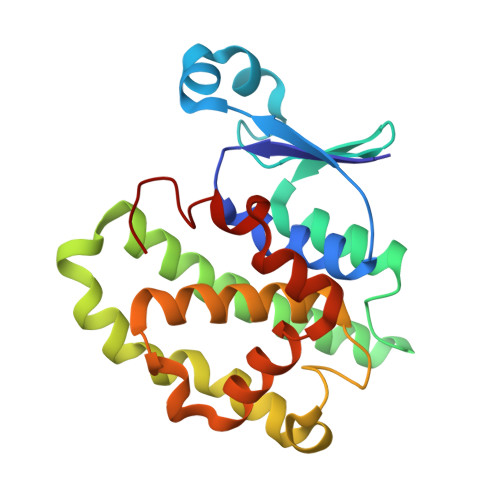Nitrosylation of human glutathione transferase P1-1 with dinitrosyl diglutathionyl iron complex in vitro and in vivo
Cesareo, E., Parker, L.J., Pedersen, J.Z., Nuccetelli, M., Mazzetti, A.P., Pastore, A., Federici, G., Caccuri, A.M., Ricci, G., Adams, J.J., Parker, M.W., Bello, M.L.(2005) J Biological Chem 280: 42172-42180
- PubMed: 16195232
- DOI: https://doi.org/10.1074/jbc.M507916200
- Primary Citation of Related Structures:
1ZGN - PubMed Abstract:
We have recently shown that dinitrosyl diglutathionyl iron complex, a possible in vivo nitric oxide (NO) donor, binds with extraordinary affinity to one of the active sites of human glutathione transferase (GST) P1-1 and triggers negative cooperativity in the neighboring subunit of the dimer. This strong interaction has also been observed in the human Mu, Alpha, and Theta GST classes, suggesting a common mechanism by which GSTs may act as intracellular NO carriers or scavengers. We present here the crystal structure of GST P1-1 in complex with the dinitrosyl diglutathionyl iron ligand at high resolution. In this complex the active site Tyr-7 coordinates to the iron atom through its phenolate group by displacing one of the GSH ligands. The crucial importance of this catalytic residue in binding the nitric oxide donor is demonstrated by site-directed mutagenesis of this residue with His, Cys, or Phe residues. The relative binding affinity for the complex is strongly reduced in all three mutants by about 3 orders of magnitude with respect to the wild type. Electron paramagnetic resonance spectroscopy studies on intact Escherichia coli cells expressing the recombinant GST P1-1 enzyme indicate that bacterial cells, in response to NO treatment, are able to form the dinitrosyl diglutathionyl iron complex using intracellular iron and GSH. We hypothesize the complex is stabilized in vivo through binding to GST P1-1.
- Department of Biology, Chemical Sciences, and Technologies, and Internal Medicine, University of Rome "Tor Vergata," 00133 Rome, Italy.
Organizational Affiliation:




















